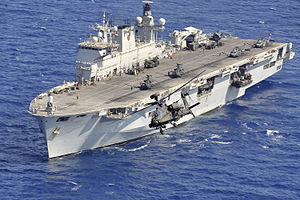HMS Ocean (L12)

HMS Ocean during Operation Ellamy and the 2011 military intervention in Libya.
|
|
| History | |
|---|---|
|
|
|
| Name: | HMS Ocean |
| Operator: | Royal Navy |
| Ordered: | 11 May 1993 |
| Builder: | Vickers Shipbuilding and Engineering Ltd, Kværner (Govan) |
| Laid down: | 30 May 1994 |
| Launched: | 11 October 1995 |
| Sponsored by: | Queen Elizabeth II of the United Kingdom |
| Commissioned: | 30 September 1998 |
| Refit: | Major 2012–2014 |
| Homeport: | HMNB Devonport, Plymouth |
| Motto: | Ex undis surgit victoria |
| Nickname(s): | "The Mighty O" |
| Honours and awards: |
|
| Status: | Active |
| Badge: |  |
| General characteristics | |
| Class and type: | Landing Platform Helicopter |
| Displacement: | 21,500 t (21,200 long tons; 23,700 short tons) |
| Length: | 203.4 m (667 ft) |
| Beam: | 35 m (115 ft) |
| Draught: | 6.5 m (21 ft) |
| Propulsion: | Two Crossley Pielstick V12 diesel engines |
| Speed: |
|
| Range: | 8,000 miles (7,000 nmi; 13,000 km) |
| Boats & landing craft carried: |
|
| Capacity: | 40 vehicles |
| Troops: | 830 Royal Marines |
| Crew: | 285 + 180 FAA/RAF |
| Sensors and processing systems: |
|
| Electronic warfare & decoys: |
|
| Armament: |
|
| Aircraft carried: |
|
| Aviation facilities: |
|
HMS Ocean is an amphibious assault ship, the UK's helicopter carrier and the fleet flagship of the Royal Navy. She is designed to support amphibious landing operations and to support the staff of Commander UK Amphibious Force and Commander UK Landing Force. She was constructed in the mid-1990s by Kvaerner Govan on the River Clyde and fitted out by VSEL at Barrow-in-Furness prior to trials and subsequent acceptance in service. She was commissioned in September 1998 at her home port HMNB Devonport, Plymouth.
An invitation to tender for a new helicopter carrier was issued in February 1992. In February 1993 The Times reported that the carrier faced cancellation due to budgetary constraints. However, at approximately the same time, British forces were engaged in operations in the Balkans, which saw the Royal Fleet Auxiliary's aviation training ship RFA Argus pressed into service as an amphibious transport ship. Argus proved totally unsuitable in terms of accommodation and facilities needed for a large Embarked Military Force (EMF), which emphasised the need for a purpose built platform. On 29 March 1993, the defence procurement minister announced that development of the new Landing Platform Helicopter (LPH) was proceeding. Two shipbuilders tendered for the contract – Vickers Shipbuilding and Engineering Ltd (VSEL) and Swan Hunter. On 11 May 1993, the government announced that VSEL had won the contract. The build was to commercial standards, reducing costs significantly and leading to a construction spend of £154 million (£283 million in 2015),, comparable to that of a Type 23 frigate. VSEL, a warship manufacturer, sub-contracted the build phase to the commercial Kværner yard in Govan, Glasgow.
...
Wikipedia
